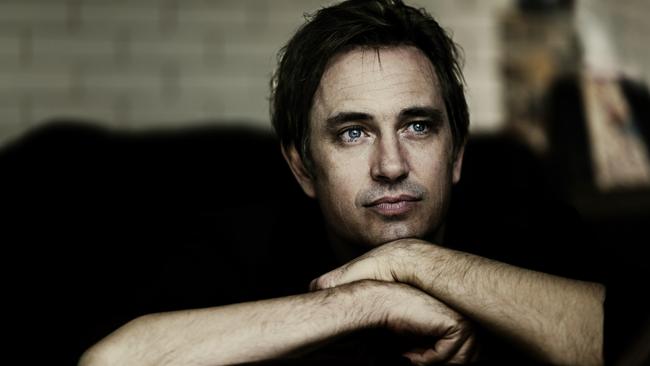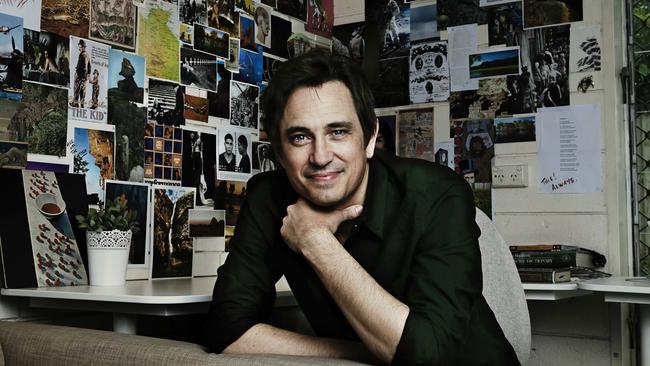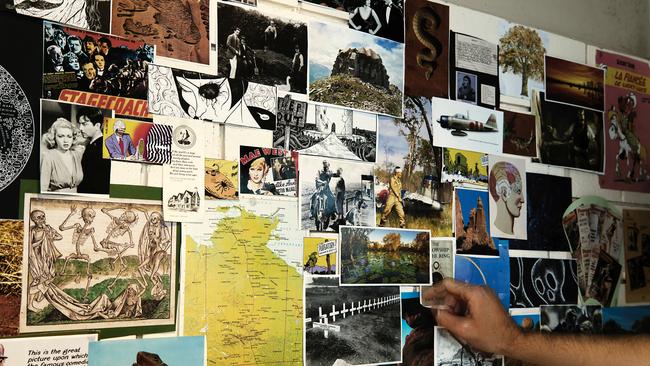Trent Dalton’s wall of wonders
We all need inspiration right now. This is how Trent Dalton finds his.

There are several reasons for my distant and strictly honourable crush on Geraldine Brooks. The way she writes. The way she channelled a formidable journalism career into a novel-writing life that gave us People of the Book and March and Year of Wonders. Western suburbs of Sydney to the top of the world. The things she says. The quote that stretches across my downstairs bunker office “mood wall” that I’m always turning to for inspiration: “Don’t be afraid to see dead people.”
I stuck that quote with Blu-Tack to my mood wall between an image of a woman diving off a clock tower and a black and white photographic portrait of Robert Smith from The Cure, who made the wall because I decided long ago that every sentence I write should aim to feel like the opening 33 seconds of Plainsong. Who knows where inspiration will come from?
The story goes that in the writing of Year of Wonders, her 2001 tale of a young widow’s will to live inside a bubonic plague village left for dead, Brooks took to walking through cemeteries and “communicating” with dead folks whose voices her wild imagination made audible again through character breadcrumbs found in the words of gravestone epitaphs.
My father adored Year of Wonders and passed it on to me many years ago so I could adore it just as much. My father is now a dead man I’m not afraid to see almost every week when I go jogging and sit down on a park bench and look up at the blue sky. I was seeing him so often and so clearly three years ago that I decided to make him walk and talk again inside a book I wrote called Boy Swallows Universe. Some weird and desperate act of resurrection; some sad and awkward season of literary Frankensteining from a boy who just wanted to spend a couple more nights in the warm campfire company of his old man.
My mood wall is currently filled with images of late-1800s graveyards and 1930s Hollywood black and white movie starlets smoking cigarettes and looking dangerous. The wall is filled with images of Daniel Day-Lewis and one of Madonna from 1985 – nobody cooler than 1985 Madonna – and wild west cowboys on horseback and strange-looking lizards from Australia’s Red Centre.

Above the Brooks quote is a line from Hemingway that my older brother texted me one recent night out of the blue: “The world breaks everyone and afterward many are strong at the broken places. But those that will not break it kills.” A quote for living if ever I’ve heard one. That might be a handy thing to remember through a seemingly endless global pandemic, too.
I stuck that quote to my mood wall because it reminded me to not be afraid to write when you’re weak. People say you have to be strong and fearless to write with all of your heart. Truth is, you have to be weak and terrified. I reckon Hemingway was scared shitless of the thoughts in his head and the words in his right hand, but he wrote ’em anyway. Every word an act of generosity, every word an act of breaking. That’s why he always hit the bottle. Shut that brilliant brain up for just a night. Or three. He broke a little bit every day. He gave in and then he was able to give us so much. He saw the sun go down so many times in his life that when he saw it rise – and it does also rise – it shone twice as bright in his eyes.
Sometimes we have to yield to life and all its tragedies and hardships; its summer firestorms and floods and its miserable, terrifying pandemics. Sometimes we gotta be water, not rock. No harm in breaking. But we must try to be strong at the broken places.
There’s an image of my two daughters on this downstairs bunker mood wall. “Hey Dad,” my youngest daughter, Sylvie, said. “Boy Swallows Universe is a book about two beautiful boys.”
“Yeah darlin’.”
“But you’re a father of two girls?”
“Yeah, darlin’.”
“Then why don’t you write a book about two beautiful girls?”
Who knows where inspiration will come from?
There’s an image of the late British author Anthony Burgess on my mood wall that reminds me not to waste my time on Earth. Roughly 27,000 days if I’m lucky and I already spent one of them watching every episode of Tiger King. In 1959, Burgess was diagnosed with a brain tumour and given less than a year to live. Terrified that his wife, Llewela, would live a life of poverty after his imminent death, Burgess feverishly wrote no less than five novels in what was supposed to be his year of death. Of course, the tumour diagnosis was wrong and he died in 1993 having authored more than 50 books. Burgess’s death notice inspired and maybe even sustained three decades of astonishing creative output that bled beyond novels into librettos, film and TV screenplays and more than 250 musical compositions. Who knows where inspiration will come from?
Haruki Murakami wakes at 4am every morning when he’s writing a novel. He smashes out those beautiful, haunting words he writes for six straight hours, breaking a little bit inside with every word, and then he repairs himself, strengthens himself at the broken places, by running for 10km and then reading someone else’s book for the rest of his day.
Some of the dialogue that I found the most powerful in Cormac McCarthy’s The Road, that monumental father-son story, was taken verbatim from conversations he shared with his own boy, John, who he dedicated the book to.
“Papa, what would you do if I died?”
“I’d want to die, too.”
“So you could be with me?”
“Yes, so I could be with you.”
Who knows where inspiration will come from?
There’s an image on my mood wall of a Japanese World War II pilot, Hajime Toyoshima. During the bombing of Darwin on February 19, 1942, Toyoshima’s Zero was hit by small-arms fire. Returning to his Japanese carrier vessel, his engine seized and he crash-landed on Melville Island. After staggering aimlessly through the scrub with pistol in hand he encountered a group of indigenous men, one of whom, Matthias Ulungura, later recounted how he crept up behind Toyoshima with a tomahawk and grabbed him by the wrist, thus becoming the first Australian to take a Japanese prisoner of war on Australian soil.
For almost a decade I’ve thought about what was going through Hajime Toyoshima’s mind when he exited his cockpit that day and found himself engulfed by a wild and suffocating and dreamlike landscape unlike any on Earth. Who knows where inspiration will come from?
I’m convinced the universe is nothing but a bully that pushes me from behind to places I want to go and places I don’t. It yanks us all by the ear sometimes like a high-socked and hairy-armed 1970s high school principal, throws us into love stories and tosses us into tragedies and jackboots us into being parents and being workers and being old and then being dead. This ever-changing mood wall of images that I have stuck above my writing desk inside my little bunker office in the northern suburbs of Brisbane, Queensland, Australia, is currently filled with images from the places the universe – and this very magazine – has pushed me to in the past two years. I’ve been finding inspiration in the shimmering landscape of Australia and I’ve been sticking our country up on my wall. A fever dream of images, every last one of which found a place inside my latest book, All Our Shimmering Skies.
I hiked the Flinders Ranges and there’s a picture on my mood wall of the majestic view of Wilpena Pound from the ragged top of Elder Range, a place not meant for humans because we don’t have wings to lift off from it like the wedge-tailed eagles that rightly call it home. Not human territory. Cloud territory. Blue sky territory.
There’s an image of Steve “Bakala” Wurramara, a man I had the privilege of meeting last year on Groote Eylandt, off the remote eastern coast of Arnhem Land. I was invited to the island for a magazine story about the MJD Foundation, an extraordinary organisation that works with Aboriginal Australians living with the genetic neurodegenerative condition Machado-Joseph Disease. The highest concentration of MJD in the world is on Groote Eylandt, where an estimated 186 members of the 1100-strong indigenous population have parents or grandparents who had it, giving them a 50 per cent chance of also having MJD. There are people on that island who look at it as a family curse passed down through generations and sourced from the sins of ancestors.
Amid the dreamlike wilderness of Groote, the deep and charismatic Steve “Bakala” Wurramara told me of the bush medicine and “bush magic” knowledge passed on to him by his father and grandmother that he is using to assist Sydney scientists in finding a treatment or cure for his MJD condition. And please forgive the flight of fancy, but I swear to God, when Steve spoke, it felt to me like there really was something mystical floating between the dirt below Groote and the sky above it. I’m probably too dumb and suburban white to understand it but a feeling is a feeling and feelings don’t always have to be understood.
That afternoon, I had a beer by the Groote Eylandt beachfront and watched the sun set and I looked up at the sky and saw my old man and I said something, not out loud but just in my head, about how grateful I was for the 12,775 days of my life I got to spend with him and how grateful I was that he set me off on a road that somehow led me to that wild and remote deep north beach with that beer in my hand. Of course, that sky didn’t talk back but that did not lessen the impact of the chat one bit. Sometimes a one-way conversation is all we need. And I’ve been thinking ever since about the sacred and private conversations we all have with the sky. Nobody ever whispered a trivial word to the sky. The sky gets all the big important words from us. Help me. Thank you. Why me? I love you. Sky talk is serious business. Beautiful business. Those sky whispers we offer are as sacred and unique to each of us as every particular patch of sky we see from wherever we stand on Earth. There’s more than clouds and stars up there. Our pasts are up there, our successes and failures, our futures.

Then I started thinking hard on a story that wasbouncing around my head. From my bunker in Brisbane I phoned a woman in Darwin named Tess Atie. She grew up in the area south-west of the city that later became Litchfield National Park, easily the Northern Territory’s best kept secret: 150,000 hectares of shimmering vine forest and cascading waterfalls, high plateaus and a lost city of weathered sandstone pillars that always look to my daydreamer eyes like scary monsters and bad men, some of whom I used to know, frozen in stone. The most jaw-dropping country I’ve ever walked through, a place I’ve returned to three times in my adult life and that’s about a thousand times fewer than Tess Atie has seen it. Tess has family all the way from Mandorah on the Cox Peninsula to Peppimenarti, beyond the Daly River. She runs Northern Territory Indigenous Tours, a wholly indigenous-owned company specialising in natural and cultural interpretation.
Over the phone, I told Tess the early bone structure of what would become All Our Shimmering Skies. It’s about gifts that fall from the sky, curses we dig from the earth and the secrets we bury inside ourselves. It’s about a motherless 12-year-old Darwin girl named Molly Hook, raised in a graveyard, who believes her family was cursed for the sins of her grandfather. As World War II bombs rain over Darwin, Molly runs into the treacherous vine forest country on an all-or-nothing quest to find the man she hopes will remove her family curse. She’s pure light and goodness, this girl, but she’s on the run from pure darkness in the form of a man who looks a bit like Daniel Day-Lewis in There Will Be Blood. But along the way our Molly is aided in her quest by the most unlikely companions: a hard-drinking, chain-smoking theatre actress – some cantankerous cross between Jean Harlow and 1985 Madonna – and a fallen Japanese fighter pilot who can’t tell the difference between the Northern Territory wilderness and the mystical plains of high heaven.
I told Tess Atie that Molly Hook, in this story, always talks to the sky and the sky talks back to her, tells her where to go, how to be strong, how to be good. She sees things in that sky. Her past and her future are in that sky and she’s not afraid to see dead people in it. And it was nice of Tess to not laugh at this notion of talking to the sky. “Mmmm,” she simply said, and that sounded to me like, “Well, who doesn’t?”
I told Tess that I wanted to set Molly Hook off on a great quest and I needed to find some places in Australia’s deep north vine forest country that I could see with my own eyes, a landscape filled with wonder and magic and natural miracles, a place just like Litchfield National Park but seen through the eyes of this strange girl in my head who I was beginning to care about, a girl who didn’t look too dissimilar in size and shape and personality to my own daughters, aged 11 and 13.
“Come on up,” Tess said. “I’ll show you where she goes.” Who knows where inspiration will come from?
All Our Shimmering Skies by Trent Dalton (HarperCollins, $32.99) is out September 29. See extract in next weekend’s Review section.


To join the conversation, please log in. Don't have an account? Register
Join the conversation, you are commenting as Logout